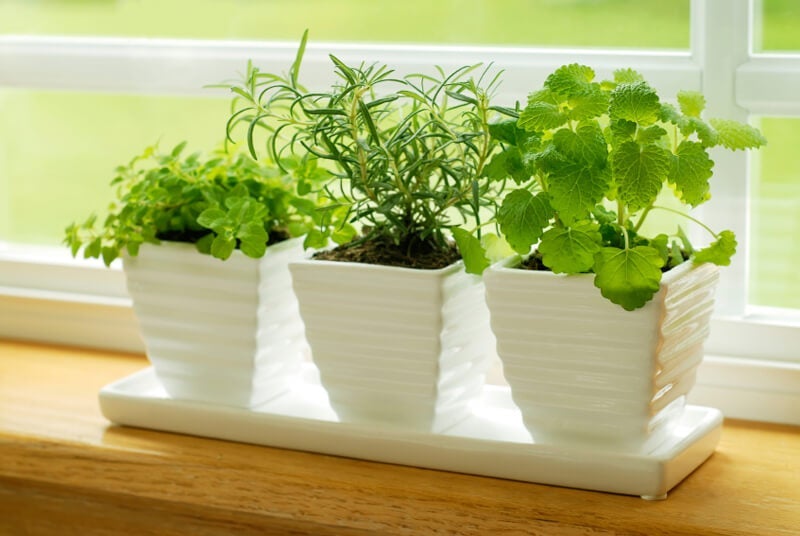Many kitchen gardeners love the convenience of fresh herbs at home, and what could be more convenient that an indoor herb garden? Even if you live in an apartment or condo without any outdoor space, you can grow herbs indoors.
The ideal setting for an indoor herb garden is the kitchen, where you can snip fresh herbs and use them in dishes without skipping a beat. If you don't have a spot in your kitchen, though, you can still grow herbs in any sunny room. And to increase your chances of success, be sure to start with strong young herbs from Bonnie Plants®, which are grown near where you live by a company with over a century of growing experience. They're also already well on their way to maturity, meaning you're that much closer to your first tasty harvest.
Follow these tips for growing herbs indoors.
Find the best spot for an indoor herb garden.
To grow well indoors, herbs need as much natural light as possible. Place them in a sunny spot near a window that faces south and receives at least 6 hours of sun daily. (While indoor light is not quite as intense as direct light outdoors, light coming in through an unblocked, south-facing window is enough for most herbs.) Some herbs that require less light, like mint, parsley, and thyme, can also grow well in west-facing windows.
Be sure to keep an eye out for signs that your herbs are not getting enough light. These include poor growth, stems that grow unusually long between leaf sets, leaves that are smaller than usual, and stems or leaves that are abnormally pale or begin to turn yellow.
One easy way to ensure your indoor herbs are getting enough light no matter where place them is to use a grow light, which mimics direct sunlight. This is a great solution when you're short on southern-exposure window space. It's also an excellent way to provide extra light in the winter, when there's less daylight.
Give indoor herbs good drainage.
The best way to ruin a tabletop or windowsill is to let a potted plant drain on it. Likewise, the best way to ruin most herbs is to let them sit in water so the roots will rot. Be sure to use a saucer, liner, or drain pan under the pot to catch water and protect your surface. A clay saucer lets moisture pass through, so opt for plastic, rubber, or metal instead.
Clay pots help with drainage, but they can dry out quickly. If you live in a dry climate or are growing herbs indoors during winter, when furnace heat causes homes to get especially dry, try a glazed or plastic container that won't dry out as quickly as clay.
Use a premium potting mix, such as Miracle-Gro® Indoor Potting Mix, to pot your indoor herbs. And by all means, be sure your pots have drainage holes!
Indoor herbs are happy with typical indoor temperatures.
Many cooks grow herbs indoors during the winter when it's too cold outside or too wet to dig in the dirt, but you can grow herbs inside any time of year. Indoor herbs prefer the same temperatures that most people do—around 65 to 70 degrees F—so if you're comfortable, they probably are. At night, temperatures near a window may drop to 55 or 60, but most herbs like that, too. Keep foliage from touching glass to protect from getting nipped by cold.
Basil is trickier. Many kitchen gardeners yearn for basil in their indoor garden. If you have plenty of sun and warmth indoors, basil should thrive, but don't keep it on a cool windowsill. Basil leaves will droop and fade after a short time in cool air. It prefers indoor temperatures in the 70s day and night.
Remember that the air next to a window will be cooler in winter (or hotter in summer) than your average indoor temperature, so adjust your plants accordingly. Dry air, whether from air conditioning or heating, is hard on most herbs, so you may want to consider increasing the surrounding humidity.
Indoor herb plants will probably stretch and be spindlier than plants in the outdoors, but they will still give you plenty of fresh clippings. To encourage lots of growth, fertilize regularly with plant food, such as Miracle-Gro® Water Soluble Plant Food for Vegetables & Herbs, especially if you are harvesting leaves regularly. (Be sure to follow directions!)
Grow in water.
One easy way to grow herbs indoors is to grow them in a water-based (aka hydroponic) system. Your plants grow directly in water or a soilless medium, so moisture and nutrients are delivered directly to plant roots, and a grow light provides all of the "sunlight" needed by the plants. The Miracle-Gro® Twelve™ Indoor Growing System is a great choice for growing herbs, as it's easy to use, doubles as an attractive end table, and can be managed from your smartphone.
Try growing these culinary herbs:
- Mint (Chocolate Mint, Peppermint, Spearmint, or Sweet Mint)
- Basil
- Oregano (Greek Oregano, Italian Oregano, or Hot & Spicy Oregano)
- Chives
- Lemon Balm
- Marjoram
- Parsley (Flat Italian Parsley or Curled Parsley)
- Rosemary
- Sage
- Thyme (German Thyme or Lemon Thyme)





 Herbs
Herbs
 Vegetables
Vegetables
 Fruit
Fruit
 Flowers
Flowers
 Succulents
Succulents

